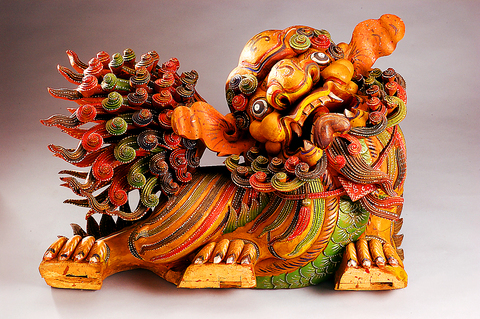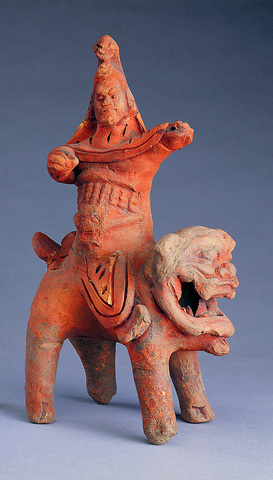It is said that most Taiwanese practice a mixture of Buddhism, Taoism and folk beliefs. But what are these folk beliefs and how are they
practiced?
Taiwanese folk religion is centered on the concepts of attracting good fortune and repelling ill fortune. Pursuing Good Fortune -- Taiwanese Folk Cultural Artefacts, the new special exhibition at the Museum of World Religions in Yonghe (

The entryway to the exhibition is narrow and crooked and co-vered with floor-to-ceiling pictures of brick walls and curving Chinese roofs. It gives you the sense of walking through the narrow alleyways of a small town somewhere in Taiwan.
The first section of the exhibition is dedicated to "spaces" and contains a temple display and a residential display. The representation of a traditional Taiwanese temple is much simplified yet unmistakable: Imposing, angry-looking painted generals stand guard on either side of the door; stylized mythical beasts sit atop beams and pillars; and the altar inside is illuminated with red light.
Special attention is given to the beasts in this section of the exhibition. The sculptures of phoenixes, dragons and lions all have their specific duties of protecting the temple. For example, a dragon-fish beast called the aoyu (

Some of the more humorous items in the residential display are the clay "wind lions" (
The section on personal items contained mostly pendants worn to ward off evil spirits, including the donut-shaped coin pendants that are still popular today.
Some of the exhibition's most beautiful items were the ceremonial baby clothes in the stages-of-life section. The little caps adorned with embroidered mythical beasts were especially

adorable.
As informative as the exhibition is, non-Chinese-reading visitors should bring a Taiwanese friend along with them to
translate, as the artefacts' descriptions are in Chinese only.
The NT$150 ticket for admission gets you into the rest of the museum, which contains some lovely displays, such as intricate models of major world temples. To get to the museum, take the Nanshijiao MRT line to Dingxi Station and wait for the free Sogo shuttle outside Exit 1. The museum is in the same building as Sogo.
Exhibition notes
What: Pursuing Good Fortune ? Taiwanese Folk Cultural Artefacts(
Where: Museum of World Religions, 7F, 236 Zhongshan Rd, Yonghe, Taipei (
Telephone: (02) 8231 5966
When: To Feb. 10, 2006

Most heroes are remembered for the battles they fought. Taiwan’s Black Bat Squadron is remembered for flying into Chinese airspace 838 times between 1953 and 1967, and for the 148 men whose sacrifice bought the intelligence that kept Taiwan secure. Two-thirds of the squadron died carrying out missions most people wouldn’t learn about for another 40 years. The squadron lost 15 aircraft and 148 crew members over those 14 years, making it the deadliest unit in Taiwan’s military history by casualty rate. They flew at night, often at low altitudes, straight into some of the most heavily defended airspace in Asia.

Taiwan’s democracy is at risk. Be very alarmed. This is not a drill. The current constitutional crisis progressed slowly, then suddenly. Political tensions, partisan hostility and emotions are all running high right when cool heads and calm negotiation are most needed. Oxford defines brinkmanship as: “The art or practice of pursuing a dangerous policy to the limits of safety before stopping, especially in politics.” It says the term comes from a quote from a 1956 Cold War interview with then-American Secretary of State John Foster Dulles, when he said: ‘The ability to get to the verge without getting into the war is

Beijing’s ironic, abusive tantrums aimed at Japan since Japanese Prime Minister Sanae Takaichi publicly stated that a Taiwan contingency would be an existential crisis for Japan, have revealed for all the world to see that the People’s Republic of China (PRC) lusts after Okinawa. We all owe Takaichi a debt of thanks for getting the PRC to make that public. The PRC and its netizens, taking their cue from the Chinese Communist Party (CCP), are presenting Okinawa by mirroring the claims about Taiwan. Official PRC propaganda organs began to wax lyrical about Okinawa’s “unsettled status” beginning last month. A Global

Like much in the world today, theater has experienced major disruptions over the six years since COVID-19. The pandemic, the war in Ukraine and social media have created a new normal of geopolitical and information uncertainty, and the performing arts are not immune to these effects. “Ten years ago people wanted to come to the theater to engage with important issues, but now the Internet allows them to engage with those issues powerfully and immediately,” said Faith Tan, programming director of the Esplanade in Singapore, speaking last week in Japan. “One reaction to unpredictability has been a renewed emphasis on